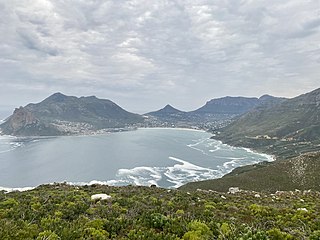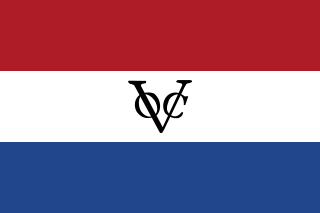Related Research Articles
The written history of the Cape Colony in what is now South Africa began when Portuguese navigator Bartolomeu Dias became the first modern European to round the Cape of Good Hope in 1488. In 1497, Vasco da Gama sailed along the whole coast of South Africa on his way to India, landed at St Helena Bay for 8 days, and made a detailed description of the area. The Portuguese, attracted by the riches of Asia, made no permanent settlement at the Cape Colony. However, the Dutch East India Company (VOC) settled the area as a location where vessels could restock water and provisions.

Johan Anthoniszoon "Jan" van Riebeeck was a Dutch navigator, ambassador and colonial administrator of the Dutch East India Company.

The Griquas are a subgroup of mixed-race heterogeneous formerly Xiri-speaking nations in South Africa with a unique origin in the early history of the Dutch Cape Colony. Like the Boers they migrated inland from the Cape and in the 19th century established several states in what is now South Africa and Namibia. The Griqua consider themselves as being South Africa’s first multiracial nation with people descended directly from Dutch settlers in the Cape, and local peoples.
The following lists events that happened during the 1660s in South Africa.
The following lists events that happened during the 1670s in South Africa.
The following lists events that happened during the 1680s in South Africa.

Hout Bay is a seaside suburb of Cape Town in the Western Cape province of South Africa. It is situated in a valley on the Atlantic seaboard of the Cape Peninsula, twenty kilometres south of the Central business district of Cape Town. The name "Hout Bay" can refer to the town, the bay on which it is situated, or the entire valley.

The Castle of Good Hope is a bastion fort built in the 17th century in Cape Town, South Africa. Originally located on the coastline of Table Bay, following land reclamation the fort is now located inland. In 1936 the Castle was declared a historical monument and following restorations in the 1980s it is considered the best preserved example of a Dutch East India Company fort.

The area known today as Cape Town has no written history before it was first mentioned by Portuguese explorer Bartholomeu Dias in 1488. The German anthropologist Theophilus Hahn recorded that the original name of the area was '||Hui !Gais' – a toponym in the indigenous Khoi language meaning "where clouds gather."

Georg Friedrich Wreede or Georgius Fredericius Wreede was governor of Dutch Mauritius from 1665 to 1672, with a break between 1668-1669.
Autshumato was a chief of the Khoikhoi Gorinhaikonas who worked as an interpreter for the Europeans in present-day, Cape Town, South Africa prior and during the establishment of the Dutch settlement on the Cape of Good Hope in 1652.

The Khoikhoi–Dutch Wars were a series of conflicts that took place in the latter half of the 17th century in what was known then as the Cape of Good Hope, in the area of present-day Cape Town, South Africa, between Dutch colonisers who came from the Netherlands and the local African people, the indigenous Khoikhoi.

Although the Portuguese basked in the nautical achievement of successfully navigating the cape, they showed little interest in colonization. The area's fierce weather and rocky shoreline posed a threat to their ships, and many of their attempts to trade with the local Khoikhoi ended in conflict. The Portuguese found the Mozambican coast more attractive, with appealing bays to use as waystations, prawns, and links to gold ore in the interior.

The Dutch Cape Colony was a Dutch United East India Company (VOC) colony in Southern Africa, centered on the Cape of Good Hope, from where it derived its name. The original colony and the successive states that the colony was incorporated into occupied much of modern South Africa. Between 1652 and 1691, it was a Commandment, and between 1691 and 1795, a Governorate of the VOC. Jan van Riebeeck established the colony as a re-supply and layover port for vessels of the VOC trading with Asia. The Cape came under VOC rule from 1652 to 1795 and from 1803 to 1806 was ruled by the Batavian Republic. Much to the dismay of the shareholders of the VOC, who focused primarily on making profits from the Asian trade, the colony rapidly expanded into a settler colony in the years after its founding.

Roelof Diodati was a governor of Dutch Mauritius in the late 17th century.

Slavery in South Africa existed from 1653 in the Dutch Cape Colony until the abolition of slavery in the British Cape Colony on 1 January 1834. This followed the British banning the trade of slaves between colonies in 1807, with their emancipation by 1834. Beyond legal abolition, slavery continued in the Transvaal though a system of inboekstelsel.

Free Burghers were early European colonists in the 18th century who had been released of their service contracts to the Dutch East India Company (VOC) and had become full citizens (burghers). The introduction of Free Burghers to the Dutch Cape Colony is regarded as the beginning of a permanent settlement of Europeans in South Africa. The Free Burgher population eventually devolved into two distinct segments separated by social status, wealth, and education: the Cape Dutch and the Boers.

The Battle of Salt River was a small military engagement between the crew of a Portuguese fleet led by Francisco de Almeida and the indigenous ǃUriǁʼaekua "Goringhaiqua" in Dutch approximate spelling), notable for being the first military encounter between Europeans and indigenous people in what would later become South Africa. The battle resulted in a massacre of Portuguese forces and a victory for the ǃUriǁʼaekua.
Doman was a Khoikhoi tribesman and interpreter with the Dutch settlers at the Cape of Good Hope. He was one of the first interpreters employed by the Dutch East India Company at their settlement on the Cape. After being taken to Java in 1657, he witnessed the company's subjugation of the native people there and turned against the Dutch. Shortly after his return to Africa, he led his people in the First Khoikhoi-Dutch War of 1659–1660. They were unable to storm the company's fort, and Doman was wounded, after which the war ended and Doman returned to Dutch employment.
Angela van Bengale was one of the earliest known slaves taken to the Cape Colony and the mother of former slave and later wealthy socialite Anna de Coningh.
References
- ↑ kedibone (31 May 2013). "Bernert Willemsz Wijlant, the first White baby, is born at the Cape". www.sahistory.org.za. Retrieved 12 July 2017.
- ↑ Anonymous (16 March 2011). "The Directors of the Dutch East India Company propose Hout Bay to Jan van Riebeeck as a possible area to settle some Dutch families". www.sahistory.org.za. Archived from the original on 6 October 2015. Retrieved 12 July 2017.
- ↑ tinashe (30 April 2012). "Jan van Riebeeck establishes the Burgher Militia a few days before the Hottentot (Khoi-Khoi) rising at the Cape". www.sahistory.org.za. Retrieved 12 July 2017.
- ↑ Mountain, Alan (2004). An Unsung Heritage. p. 18.
- ↑ Riebeeck, Jan van (1897). Riebeeck's Journal. p. 118.
- ↑ Leander (2 April 2015). "The Early Cape Slave Trade". www.sahistory.org.za. Retrieved 12 July 2017.